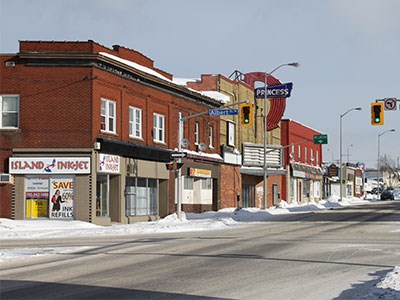The City of Sault Ste. Marie is undertaking what many cities before it have done: a downtown Community Improvement Plan (CIP) intended to transition the area into a thriving neighbourhood in which people will want to work, live and play.
Under the $2.5-million plan, funding would be available for improvements via four programs: incremental tax rebates, private sector assistance grants, public realm and streetscaping planning, and streetscape improvements.
“The downtown CIP is an overall goal,” said Steve Turco, a senior planner with the city’s engineering and planning department, “and it’s really meant to help transition the downtown from what people think about as the traditional main street to people thinking more it of as a neighbourhood with a commercial component to it that serves not only the needs of community, but really serves the immediate needs of the neighbourhood.”
The plan is being developed with three goals in mind: attract more people to live downtown, support the existing local businesses, and improve the feel of the downtown as a place unique to the Sault. Improvements for pedestrians, more cycling opportunities, better access to public transit, and streetscape improvements are all on the docket.
An area of particular interest is Gore Street, located in the west end of the city.
“There are socioeconomic issues surrounding Gore Street and the surrounding neighbourhood, but our hope is if we can do some kind of streetscape improvements then maybe that can generate some interest in bringing more activity to Gore Street,” Turco said.
As part of the plan, the city is simultaneously implementing its Canal District Study, which encompasses sites poised for redevelopment in the downtown’s west end, including the St. Marys Paper mill site, the Gateway site, the International Bridge Plaza, and the OLG Casino.
The city wants the sites to be seamlessly interwoven, so people can walk between them. Turco acknowledges, however, there are some barriers that will have to be addressed, such as the Carmen’s Way truck route which intersects the downtown, or Bay Street, which hosts fast-travelling vehicles across four lanes of traffic.
“We want to ensure that all these potential developments that are happening on these sites… are connected and they all work together, as opposed to creating little islands unto themselves that have no real interaction or connectivity between them,” Turco said.
A city’s downtown is often indicative of the overall well-being of the community, he said, but most Northern Ontario communities are challenged to cultivate sustainable economic development.
“If you’re trying to attract businesses or students or newcomers to your community, one of the showpieces for most communities is their downtown,” Turco said. “If that’s not something that you can show off or there are issues with it then it’s going to be really hard to attract people that could potentially bring wealth to the community.”
In the Sault, the Economic Development Corporation is establishing a downtown incubator to assist small businesses in getting their ventures off the ground. Turco said it’s this kind of thinking that complements the overall downtown strategy.
But the overhaul of the downtown isn’t something that can be tied up in a neat, three-year project, but an ongoing initiative that will evolve over time to meet the needs of residents, business owners and visitors, Turco said.
“It’s really looking at downtown as a mechanism to provide that complete community where you can work, live and age, you can play, all within a certain geographic area of the community,” he said.
To advance the CIP, the city has committed $300,000 from its Economic Development Fund, the Business Improvement Area is expected to provide $35,000, and it’s anticipated the private sector will contribute $600,000.
The city is now in the process of applying for $857,500 in funding each from FedNor and the Northern Ontario Heritage Fund Corp. If approved, Turco said the city would start rolling out the programs this spring.




